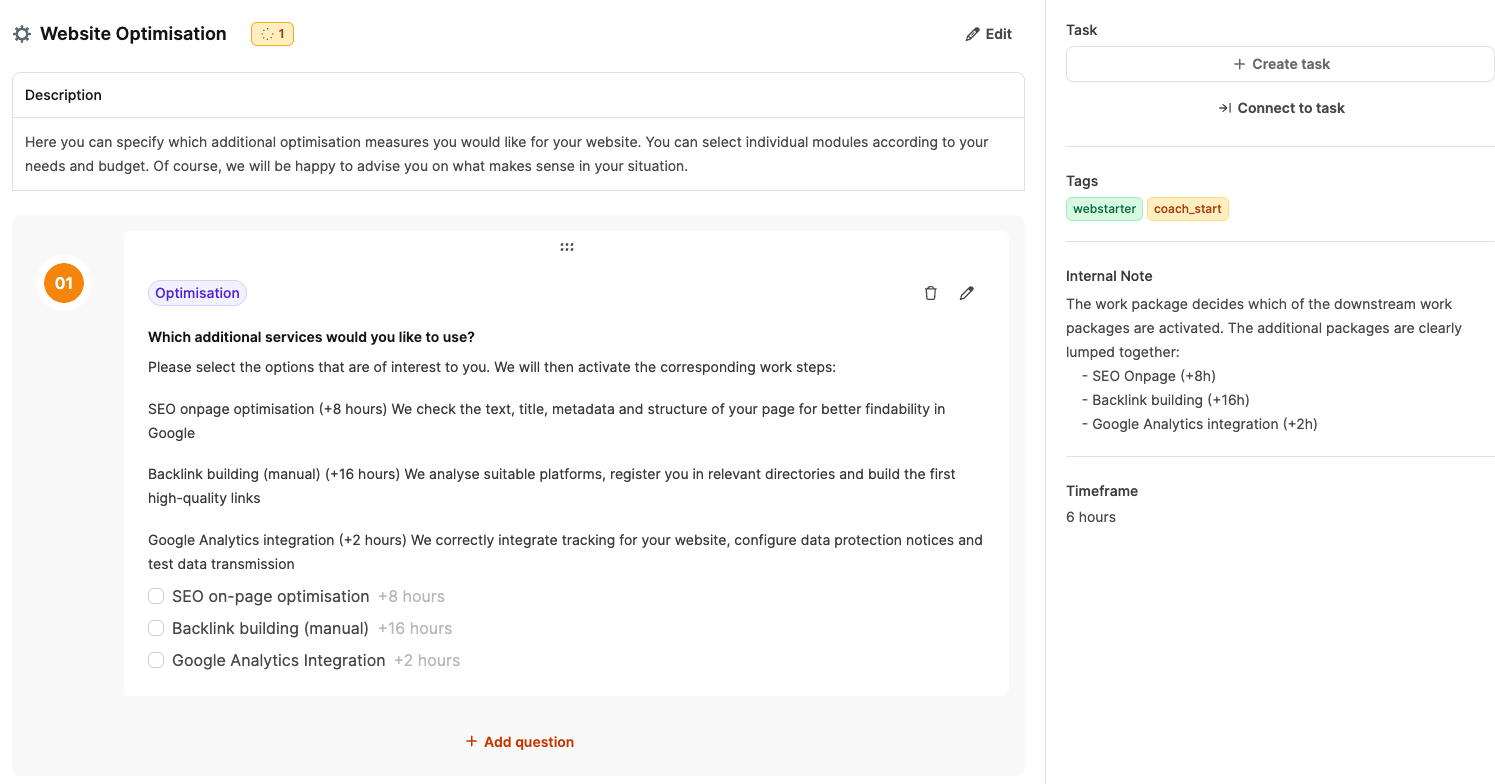In Leadtime, project efforts are calculated based on the effort entries stored in the project components.
Each component includes standardized work packages with a minimum effort in hours. Using questionnaires, these base values can be dynamically adjusted to match the project's actual needs. This creates a precise and transparent effort estimation, which flexibly adapts to different project scenarios.
Each work package defines:
a minimum effort (time frame) – the base effort needed for the standard execution,
a questionnaire, used to capture extra requirements.
The answers in the form can increase the effort, leave it unchanged or, with checkboxes and multipliers, be calculated based on quantity.
The system then automatically calculates the total projected project effort from this.

This work package lets you pick optional optimization measures for a website.
It has a minimum effort of 6 hours, which covers the technical check and basic optimization.
With a checkbox question, customers can enable extra services. Each choice bumps up the effort by the given value.
Option | Description | Additional effort |
SEO Onpage Optimization | Review and adjustment of texts, titles, metadata and page structure for better discoverability in Google. | +8h |
Backlink Building (manual) | Research of suitable platforms, listing in directories, building the first high-quality backlinks. | +16h |
Google Analytics Integration | Integration of tracking, setup of privacy notices, testing of data transmission. | +2h |
A customer chooses the services
SEO Onpage Optimisation (+8h) and
Google Analytics Integration (+2h).
The effort is calculated as follows:
Base effort (6h) + 8h + 2h = 16 hours total effort
If the customer also chooses Backlink Building, the total effort increases to 32 hours.

Checkboxes are used when multiple options can be selected at the same time. They're great for situations where a customer wants to flexibly combine extra services or modules. Every checked box adds the effort for its associated value.
Example: In the work package Website Optimisation, the customer can choose several optimisation actions:
SEO Onpage Optimisation → +8 hours
Backlink Building (manual) → +16 hours
Google Analytics Integration → +2 hours
If the customer selects all three options, the total extra effort comes to 26 extra hours. So checkboxes allow modular, additive calculation within a work package.

Radio buttons are used in forms when only one answer can be picked from a bunch of options. They're the best fit for either-or choices that can have different impacts on project effort.
In the example shown, the answer decides if a legally compliant imprint and a privacy policy already exist or still need to be created:
Yes, I have both → no extra effort
No, please create new → +2 hours
This way, the workload can be adjusted automatically, without multiple options being active at the same time.

The multiplier is used when the workload depends on an amount or quantity – so when a task is done several times. Instead of choosing fixed options, the user enters a number, which gets multiplied with a predefined number of hours.
In the example, you're supposed to enter how many blog articles will be created:
Effort per article: 2 hours
Entered quantity: 5 articles
→ The total effort is calculated automatically as 2h × 5 = 10 hours
Multipliers are useful for repeated or quantity-based tasks, e.g. texts, products, pages, datasets, or designs.

Checklists and acceptance tests can also require effort.
Here, only a flat minimum effort is possible, which is estimated and entered when creating the element.
It’s used to calculate the time needed for the review or execution of tests.